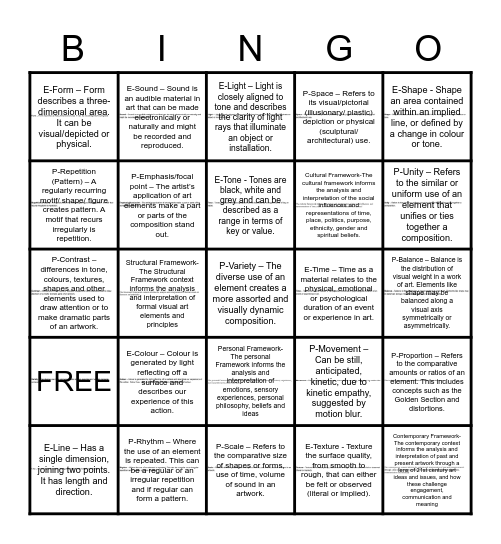

This bingo card has 24 images, a free space and 24 words: E-Line – Has a single dimension, joining two points. It has length and direction., E-Colour – Colour is generated by light reflecting off a surface and describes our experience of this action., E-Tone - Tones are black, white and grey and can be described as a range in terms of key or value., E-Texture - Texture the surface quality, from smooth to rough, that can either be felt or observed (literal or implied)., E-Shape - Shape an area contained within an implied line, or defined by a change in colour or tone., E-Form – Form describes a three-dimensional area. It can be visual/depicted or physical., E-Sound – Sound is an audible material in art that can be made electronically or naturally and might be recorded and reproduced., E-Light – Light is closely aligned to tone and describes the clarity of light rays that illuminate an object or installation., E-Time – Time as a material relates to the physical, emotional or psychological duration of an event or experience in art., P-Balance – Balance is the distribution of visual weight in a work of art. Elements like shape may be balanced along a visual axis symmetrically or asymmetrically., P-Contrast – differences in tone, colours, textures, shapes and other elements used to draw attention or to make dramatic parts of an artwork., P-Emphasis/focal point – The artist’s application of art elements make a part or parts of the composition stand out., P-Movement – Can be still, anticipated, kinetic, due to kinetic empathy, suggested by motion blur., P-Proportion – Refers to the comparative amounts or ratios of an element. This includes concepts such as the Golden Section and distortions., P-Repetition (Pattern) – A regularly recurring motif/ shape/ figure creates pattern. A motif that recurs irregularly is repetition., P-Rhythm – Where the use of an element is repeated. This can be a regular or an irregular repetition and if regular can form a pattern., P-Scale – Refers to the comparative size of shapes or forms, use of time, volume of sound in an artwork., P-Space – Refers to its visual/pictorial (illusionary/ plastic) depiction or physical (sculptural/ architectural) use., P-Unity – Refers to the similar or uniform use of an element that unifies or ties together a composition., FREE, Structural Framework- The Structural Framework context informs the analysis and interpretation of formal visual art elements and principles, Personal Framework-The personal Framework informs the analysis and interpretation of emotions, sensory experiences, personal philosophy, beliefs and ideas, Cultural Framework-The cultural framework informs the analysis and interpretation of the social influences and representations of time, place, politics, purpose, ethnicity, gender and spiritual beliefs. and Contemporary Framework- The contemporary context informs the analysis and interpretation of past and present artwork through a lens of 21st century art ideas and issues, and how these challenge engagement, communication and meaning.
Art Elements and Principles Bingo | Art Review | Art Vocabulary | S3/M1 Bingo | Sculpture 2, Module 1 Bingo
Share this URL with your players:
For more control of your online game, create a clone of this card first.
Learn how to conduct a bingo game.
With players vying for a you'll have to call about __ items before someone wins. There's a __% chance that a lucky player would win after calling __ items.
Tip: If you want your game to last longer (on average), add more unique words/images to it.